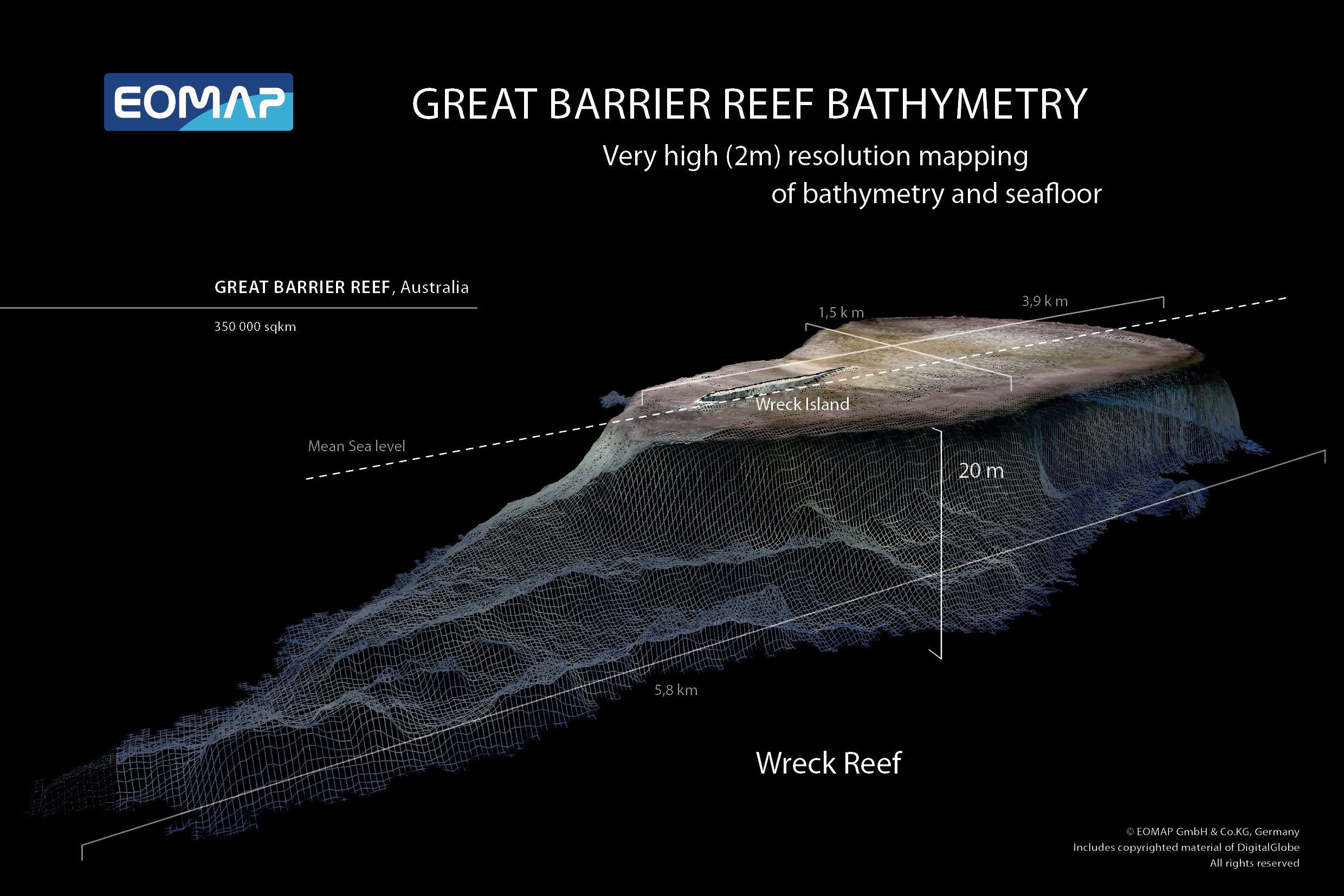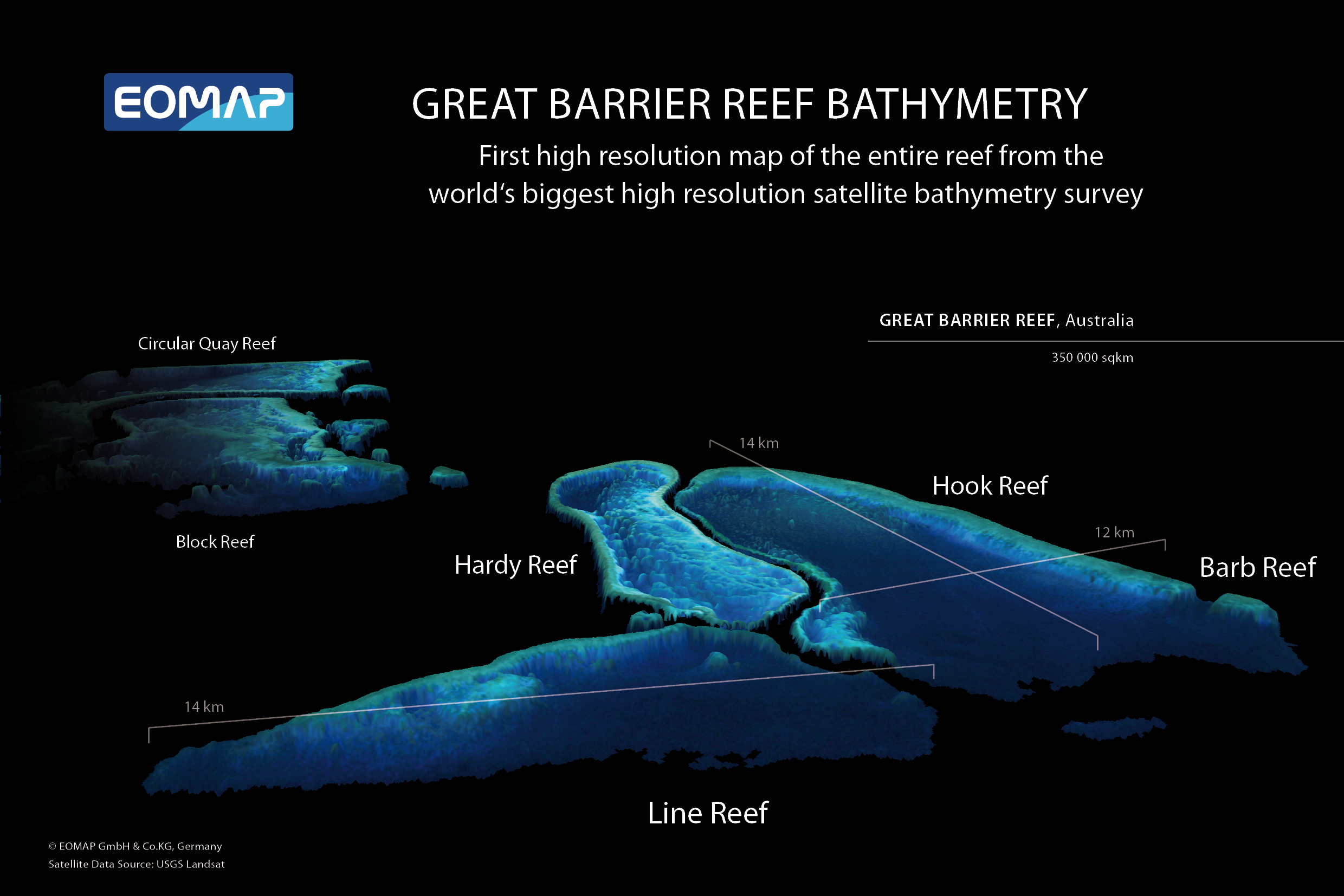The two main product types available are:
digital, shallow water bathymetry maps for any or all parts of the Great Barrier Reef and
digital, shallow water seafloor reflectance (color and brightness) maps for any or all parts of the Great Barrier Reef.
Please note that all bathymetry products are at a nominal 10 cm vertical resolution.
digital, shallow water bathymetry maps for any or all parts of the Great Barrier Reef and
digital, shallow water seafloor reflectance (color and brightness) maps for any or all parts of the Great Barrier Reef.
Please note that all bathymetry products are at a nominal 10 cm vertical resolution.
From POB
OMAP said it would present the world-first 3D habitat map of the Great Barrier Reef at the International Forum on Satellite-Derived Bathymetry in Australia. (Video available.)
500 m resampled map
International aquatic remote sensing company EOMAP said it would showcase the world-first 3D habitat map of the Great Barrier Reef (GBR) at the International Forum on Satellite-Derived Bathymetry, SDB Day 2019, May 14-16, 2019 in Australia.
The mapping project, ‘3D live habitats for the full extent of the Great Barrier Reef’, will provide, for the first time, maps of the predicted coral types and underwater landscape for the more than 3,000 reefs within the 350,000 km2 of the Great Barrier Reef (GBR).

EOMAP is the technology partner in the project with the University of Queensland (UQ), Great Barrier Reef Marine Park Authority, and the Australian Institute of Marine Science..
The resulting maps will be at an unprecedented 10m horizontal grid resolution and reveal bathymetry (water depth), geomorphic zonations and bottom types, in addition to the predicted coral types.
EOMAP SDB of Ningaloo Reef using the Landsat 8 sensor, at 30 meter horizontal resolution, down to a depth of 17.5 m.
Ningaloo reef with the GeoGarage platform (AHS nautical chart)
“No maps exist to date that provide so much detail for every single reef,” said Dr. Chris Roelfsema, project leader, from the Remote Sensing Research Centre at UQ.
He explains that a lack of detail in existing maps is an ongoing issue in environmental science.
“To understand and protect an environment you need to know the highest level of detail,” he said. "It's like managing your budget, if you don’t know exactly how much you have, then how do you know what to do?”
German and Australian scientists launched a set of groundbreaking, high resolution, shallow water topography maps for the entire Great Barrier Reef.
These world-first digital maps of the coral reefs, using satellite derived depth (bathymetry) techniques, are a critical step towards identifying, managing and essentially preserving and protecting what lies within the waters of this global icon.
for further information and data access: www.eomap.com/great-barrier-reef/
The ambitious scope of this undertaking was made possible by recent advances in satellite-mapping technologies, environmental modelling and image classification methods.
Using the European Space Agency Sentinel-2 platform satellite imagery, EOMAP applied its proprietary technology to retrieve satellite-derived bathymetry (SDB) and sub-surface reflectance (SSR).
The result of the SDB mapping is a 3D elevation model of the seafloor, one of the cornerstone data layers for the entire project.
“Accurately mapping bathymetry using satellite imagery requires very sophisticated, physics-based algorithms,” explained Dr. Magnus Wettle, Managing Director of EOMAP Australia.
“Our algorithms are able to account for the path of sunlight as it travels down through the atmosphere, through the water column, reflects off the seafloor and back up to the earth-orbiting satellite sensor.”

View with the GeoGarage platform
Both the SDB and the SSR data are fundamental to the overall project.
The SDB not only directly guides the geomorphology classification but is also used for environmental modeling input to calculate wave energy environments across the GBR.
The wave energy parameter in turn informs all reef habitat classification and predicted coral types.
The SSR data provides marine ecologists with additional, important information, when revealing the theoretical seafloor color for the final habitat classification.
Recent advances in machine learning and semi-automated classification then enable the researchers to efficiently and accurately process and classify all the reefs of the GBR.
“The importance of the outcomes from this project cannot be overestimated,” added Dr. Thomas Heege, CEO of EOMAP.
“As an example, to monitor coral bleaching over the entire Reef, a serious concern given recent events, you first need to know if you are looking at bleached coral habitat or at bright, reflective sediment. The 3D live habitat map gives you this baseline environmental information, correctly geo-positioned, to within 10 meters.”
“We are extremely pleased to be working alongside our project partners in helping to enable more effective monitoring and management of the global biodiversity icon that is the Great Barrier Reef,” concluded Dr. Wettle.
Links :





No comments:
Post a Comment